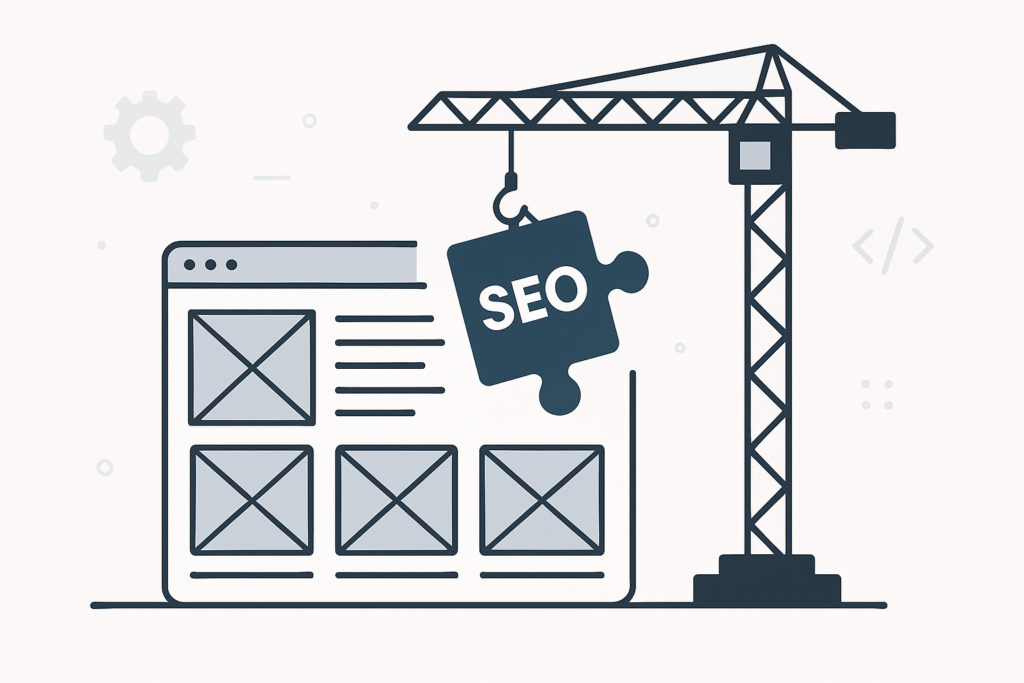The most common mistake businesses make with their websites is designing and building first, then trying to optimize later. This backwards approach costs companies thousands of dollars and months of lost traffic.
I’ve seen this mistake twice just this week. In both cases, these businesses could have saved significant time and money by planning their optimization strategy before they started building.
Table of Contents
ToggleThe Costly Mistake: Design First, Optimize Later
Earlier this week, a company reached out for SEO help. They had just finished spending $20,000 on a beautiful website with a minimalist design that had about 200 words on each page.
When I explained they’d need to add substantially more content to rank for their target terms, they refused. “We already finalized the design. It took us forever.”
The truth is, for certain search terms, you need a certain amount of content on the page. If this company wants to rank in search, they’ll have to rebuild their entire website.
@tjrobertson52 $20K website that can’t rank because they designed first, optimized never 😅 Plan your SEO BEFORE you build! #WebsiteDesign #SEO #BusinessTips
♬ original sound – TJ Robertson – TJ Robertson
Example Two: The URL Disaster
The second case involved a web design agency that had just rebuilt a client’s website. They asked me to review it from an SEO perspective.
I did what any SEO does after a site migration – I looked at all the URLs that were receiving traffic before the rebuild. Sure enough, they had replaced about half of the URLs without proper redirects.
From Google’s perspective, half of the pages were simply deleted. This means any search rankings those pages had built up were lost, along with all the traffic they were bringing in.
Why This Approach Backfires
Building before planning your optimization strategy is like laying plumbing after building walls – you’ll end up breaking things down and rebuilding later.
When you jump into design without a content strategy, you’re essentially guessing your way through SEO. You might design a few pages but later discover you need dozens of blog posts or service pages to cover key search terms.
Content Volume Matters for Rankings
Google tends to favor websites with substantial, valuable content. Research shows a strong correlation between page word count and ranking, with top-performing pages often containing 1,500+ words.
Sites that cover topics in depth using more on-page content generally rank better than minimal brochure pages. Having ample content allows you to:
- Target more keywords naturally
- Answer user questions thoroughly
- Build internal links between related pages
- Demonstrate topical authority to search engines
If you only have a handful of short pages, your site has fewer opportunities to appear in search results.
The URL Change Problem
Altering URLs during a redesign is dangerous if not handled properly. Every page that moves to a new URL must be redirected with a 301 redirect, or you risk losing all the traffic and rankings that page had built up.
As Search Engine Land explains, “for every URL that ceases to exist and causes a 404 ‘dead click’, you risk losing organic rankings and traffic.”
The Right Approach: Plan SEO From Day One
SEO should be part of your website plan from the very beginning – even before finalizing design or adding content. The earlier you implement SEO best practices, the sooner Google can discover and index your pages.
Start With Keyword Research
Before building any pages, use keyword research to plan your site’s architecture. This tells you:
- Which pages you need to build
- What content should go on each page
- How to structure your site navigation
- What topics to cover in blog posts
Plan Your Content Strategy
Map out all the content you’ll need to rank for your target terms. This includes:
- Homepage and core service pages
- Location-specific pages for local businesses
- Blog posts answering common customer questions
- Product or service detail pages
Best Practices for New Websites
When launching a new site, build in these SEO fundamentals from the ground up:
Technical Foundation
- Use HTTPS with an SSL certificate
- Ensure mobile-responsive design
- Optimize page loading speed
- Create clean, keyword-friendly URLs
- Set up XML sitemaps and robots.txt files
Content Optimization
- Include target keywords naturally in page titles and headings
- Write compelling meta descriptions under 160 characters
- Use descriptive alt text for all images
- Create unique, valuable content for each page
Monitoring and Analytics
Install Google Analytics and Google Search Console before launch. These tools let you track traffic, identify crawl errors, and monitor which pages perform best.
The Bottom Line
Don’t fall into the “beautiful but empty” website trap. Planning your SEO and content strategy before design saves you from costly rebuilds and lost search visibility.
If you’re planning a new website or redesign, start with strategy first. Define your goals, research your keywords, plan your site structure, then let that strategy guide your design decisions.
The businesses that get this right avoid the expensive mistakes I see every week. The ones that don’t often end up paying twice – once for the original site, and again to fix what should have been planned from the beginning.
Need help planning your website strategy? TJ Digital specializes in building SEO-optimized websites that rank from day one. Contact us for a free consultation.

